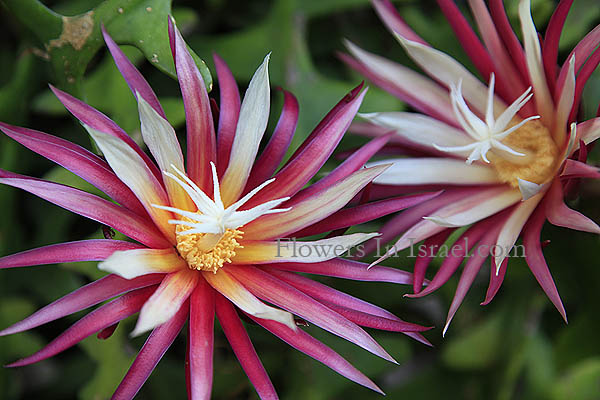Fish Bone Cactus, Rick Rack Cactus, Zig-zag cactus,
קריפטוצראוס זיגזגי
| Scientific name: | Selenicereus anthonyanus (Alexander) D. Hunt | |
| Synonym name: | Cryptocereus anthonyanus Alexander | |
| Common name: | Fish Bone Cactus, Rick Rack Cactus, Zig-zag cactus | |
| Hebrew name: | קריפטוצראוס זיגזגי | |
| Plant Family: | Cactaceae, Cactus Family, צבריים |

Location: My backyard |
| Life form: | Climbing and epiphytic (a plant that grows non-parasitically on a tree or other plant) | |
| Stems: | Primary stems clinging by aerial roots, to 2 m long or more, flattened, shallowly lobed; lateral branches to 1 m or more, 2-winged, 7-15 cm wide, broadly and deeply dentate-lobed, the lobes 25-45 mm long and 10-16 mm wide, 4-6 mm thick, tapered and curved, apex obtuse; areoles in the sinuses; | |
| Leaves: | Succulent, flat and deeply cut lobes, seem to grow in a zig-zag pattern | |
| Inflorescence: | Nocturnal, very fragrant | |
| Flowers: | White and cream, madder purple; 12 cm long | |
| Fruits / pods: | Ovoid, 6 x 5 cm long, fragrant, areoles 4 mm with spines 1–2 cm, dark green; seeds 2 x 1,5 mm, black | |
| Flowering Period: | May,June | |
| Origin: | Chiapas, Mexico |

Location: My backyard Derivation of the botanical name: Selenicereus, Greek Σελήνη, Selene, the Greek goddess of the moon, cereus(Latin), "waxy", a night-blooming cereus. anthonyanus, named for Dr. Harold E. Anthony who first flowered this species in June 1950. Cryptocereus means literally "hidden cereus".

Location: My backyard 
Location: My backyard |